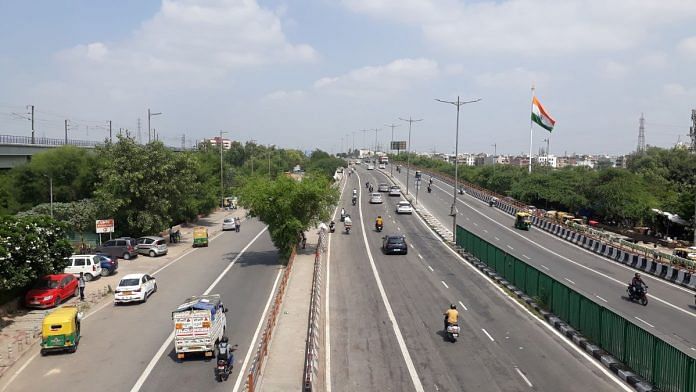New Delhi: In a bid to solve the problem of traffic congestion and high vehicular emissions, a first-of-its-kind study by The Infravision Foundation (TIF)—an independent Gurgaon-based think tank working in the sectors of energy and transportation—has used real-time traffic management data in Noida to analyse the carbon emissions, vehicle distribution, and speed limits of traffic in the city.
The report, published Tuesday, is the first pilot study to have used data from the Intelligent Traffic Management System (ITMS) which is installed as part of the Smart Cities Mission in major metropolitan cities like Delhi, Mumbai, Bengaluru, Pune, and Hyderabad, among others.
The ITMS uses AI and data analytics to enhance road safety, and reduce congestion by monitoring real-time traffic data. It collects data on everything from PM2.5 levels and carbon dioxide emissions from vehicles, to average speed reached by vehicles and speed limit violations, and also recognises the number plates of vehicles travelling on the road.
The TIF, along with IIT Delhi’s Transport Research and Injury Prevention Centre, studied this data from Noida’s ITMS, and came up with strategies with which the city could decarbonise its traffic.
“These ITMS systems are in all major cities under the Smart Cities Mission, and collect a whole host of data—but they have never been used before,” said Jagan Shah, the CEO of the Intravision Foundation. “Our project is an attempt to tell people that there is this entire goldmine of data waiting to be studied.”
In an event at the India Habitat Centre Tuesday, TIF and IIT Delhi, along with Efkon Strabag—the company that manages Noida’s ITMS data—launched their report titled ‘Decarbonizing urban transport using traffic and transport data from ICCC’. The event was also attended by V. Umashankar, the secretary of the Union Ministry of Road Transport and Highways.
The report used Noida’s Mahamaya flyover area as a case study and found how the PM2.5 levels there routinely reached 251.7 micrograms per cubic metre, which was much higher than 60 micrograms per cubic metre—the Central Pollution Control Board (CPCB) limit. By combining ITMS data with the information on the Vahan dashboard, which records India’s vehicular data, the report was able to pinpoint that diesel vehicles, despite constituting only 22 percent of the total cars that passed through the region, caused disproportionately high emissions.
“ITMS data is often used for controlling traffic during peak hours and e-challans, but it can also be used for a more sustainable goal—we can identify which vehicles cause the most pollution, at what time the emissions are high and how to curb these,” explained Geetam Tiwari, professor emeritus at IIT Delhi and one of the authors of the report.
Also Read: Delhi’s air was toxic for 56% of the days in last 5 years, AQI no reliable measure—CAG report
Smart traffic and decarbonisation
A lot of cameras, sensors, emergency call boxes, and meteorological systems are installed at traffic signals that form part of the ITMS of a city. When India launched the Smart Cities Mission in 2015, which was incidentally co-authored by Jagan Shah of Intravision, the aim was to equip 100 cities across the country with ITMS, among other things. These are all connected through an Integrated Command and Control Centre (ICCC), which makes access to this data available to the government.
“But it is not enough to just collect the data—we need to tell people to utilise it efficiently in policy making,” urged Shah during the event. “Over the years, these cameras and sensors have just been collecting this data but it has been unused for better policy interventions.”
Through its analysis and calculations, the Intravision report suggested policies like traffic rerouting during peak hours and electronic congestion pricing (ECP), which is a way to reduce traffic by charging a travel fee during peak hours.
The report also suggested the adoption of electric vehicles (EVs) as opposed to internal combustion engine (ICE) vehicles, and provided exact scenarios through which EV adoption would reduce emissions in Noida.
“We calculated that even if we replace 20 percent of the diesel vehicles on Noida’s roads with EVs, the emissions will reduce a lot—especially nitrogen oxide and hydrocarbons,” said Tiwari during her presentation.
Through spatial analysis of the traffic and emissions, the report also showed how regions like Phool Mandi and Sector 91 were hotspots for nitrogen oxide while sulphur dioxide was found more in the region around Pathways School Noida. PM2.5, on the other hand, was concentrated in the model town region.
The authors emphasised that their report was just a pilot study, and a lot more work needs to be done for proper policy interventions. However, they wanted to display how ITMS data could be used from various other cities too for similar decarbonisation strategies.
“Harnessing the power of big data mining for decarbonising urban transport has the potential to disrupt the status quo in transportation, enabling us to reimagine the way we move people and goods,” said Shah.
(Edited by Radifah Kabir)
Also Read: Delhi’s vehicular fumes contribute 17% of air pollution Monday. Crop burning, no wind make it worse






